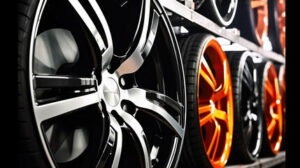Choosing Truck Wheels And Tires
Truck Wheels And Tires are an integral part of any truck build. But choosing the right ones can be tricky – especially if you don’t know what to look for.
First of all, you must consider the size. Larger wheels offer a bolder look but also increase rolling resistance, which can result in decreased fuel efficiency.
When buying new tires, it’s important to know which size you need. There are different sizes for trucks, cars, and SUVs. The size is indicated by three numbers and sometimes letters. The first number indicates the width of the tire in millimeters. The second number indicates the rim diameter in inches. The last number indicates the tire’s load capacity. This information is vital to know, as it lets you determine if the tire can handle the weight of your truck or car.
Some drivers install bigger wheels on their trucks to improve the traction of their vehicles on rough terrain. This is called plus-sizing. The increased traction can help you drive on difficult terrain, but it can also cause the truck to lose speed on smooth roads.
It’s also important to consider the wheel and tire style when choosing a replacement. Steel wheels are a good choice for trucks that carry heavy loads. However, they can rust over time. Aluminum wheels are a lighter option that can reduce the amount of wear and tear on the tires. They’re also available in a variety of colors and styles to match your truck’s appearance.
If you’re shopping for tires, make sure you look at the label on the side of the tire. The first number may be “P,” which stands for passenger vehicle. The second number may be “LT,” which means that the tire meets light truck standards. If the second number is “ST,” the tire is designed for trailers and has a higher psi rating than a regular tire. If you don’t pay attention to the number, you may end up with a set of tires that aren’t compatible with your truck.
Type
Truck wheels are typically larger than those of cars. This gives them a bigger contact patch with the road, which helps in handling dirt and pavement. However, trucks can also benefit from lower, wider rims because they allow for more ground clearance. This can save the underbelly of your vehicle from hitting common road obstacles and allows for a smoother, more comfortable highway ride.
Another major difference between truck and car tires is their load rating. While sedans, coupes and crossover SUVs use passenger tires, trucks and full-size vans require a specific tire type with a higher load capacity to handle heavier cargo loads. This includes trailers and large loads, which can place a lot of stress on the tires. Choosing the right truck tires with a high load rating will ensure your vehicle can take on these tasks while offering safe and reliable driving performance.
All-terrain truck tires are a great option for those who spend most of their time away from paved roads. They offer superior traction capabilities in challenging conditions and can help you navigate dirt and gravel driveways, grass fields and even muddy ruts. These tires tend to have larger tread lugs for increased traction and are made with materials that withstand harsh environments.
Highway truck tires are designed to enhance your vehicle’s highway performance by offering a quiet, comfortable ride and long wear. These tires have low road noise and a smooth tread design, which help to reduce vibration and increase fuel efficiency. These tires are often made with lighter material like aluminum to reduce the weight of the vehicle, which in turn improves its acceleration.
Style
The style of truck tires and wheels can add a lot to the look of your vehicle. They also can change how your vehicle handles and performs on the road and trails. There are many options available for both styles and looks.
For example, some wheels are powder coated, which is a durable finish that resists scratches and rust and can help protect the wheel from chemicals found in gasoline and oil. Other wheels are chrome, which can give your vehicle a bold, sleek look that makes it stand out from the crowd. You can even find two- and three-piece wheels to allow for more customization and creativity in your design.
It’s important to remember that truck tires are different from passenger car tires in terms of their construction and purpose. While passenger car tires are structured to increase your speed, truck tires are designed to provide traction and succor on rough terrains and off-roading environments.
You should also consider what you use your truck for when selecting a tire and wheel combination. You want to select a wheel that looks good and will complement your build, but you also want to make sure that the load rating supports any hauling or towing you plan to do with your truck.
RNR offers a great way to get an idea of what your new wheels and tires will look like on your truck with its visualizer tool. Simply enter your year, make and model into the visualizer to choose from a large selection of light truck wheels and tires. It’s the perfect way to get an idea of what your truck will look like on the road or trail before you make a purchase.
Directional
A directional tire is designed to rotate in only one direction, and it’s usually built for high-performance vehicles. The tread pattern allows the tires to channel water away when you’re driving in wet conditions and also improves traction on different surfaces. These tires are a great option for truck owners who spend the majority of their time on off-road paths and other challenging terrains.
Some directional tires also have a V-shaped groove pattern that helps resist hydroplaning on wet road surfaces. This makes them popular among truck owners who want to get the best performance out of their vehicle. Directional tires are also available in a wide variety of styles, so you can find the perfect look for your truck.
Most directional tires have an arrow or other indicator on the side wall that indicates the direction they should be mounted on your vehicle. The arrow is typically pointing toward the front of your truck, and it’s important to follow this direction when mounting your tires. This helps maintain even wear across the treads of your tires over time.
In contrast, symmetrical tires have the same tread pattern on both sides of the tire. They do not require a specific mounting direction, making them easier to rotate than directional tires. This type of tire is recommended for drivers who want the best mileage and a long-lasting, smooth ride.
When it comes to rotating your tires, the most common rotation pattern is the “front-to-rear” pattern. This rotation method involves moving the front tires to the rear and then back to the front, which helps ensure even tread wear and extends the life of your tires. The other two rotation patterns, known as the “switch” and “cross” methods, are less effective at distributing tread wear evenly and may result in uneven wear on your tires.
Look
Truck wheels and tires are a major component of your vehicle’s performance. They can transform the way your truck looks and also affect its ability to handle different terrains. There are many different types of wheels and tires available to fit your needs, including street or highway tires and all-terrain or mud tires. There are also rims that offer different finishes, such as gloss or matte. These finish choices can impact how much maintenance they require.
Another important factor to consider when choosing truck wheels is the type of look you want for your truck. Some styles are more dramatic than others, and the size of your tires will also affect how they look. For example, larger tires usually have a lower sidewall than smaller ones. This can create a more aggressive look, but it may also make the tires less responsive to road conditions and cause a harsher ride.
A final thing to keep in mind when choosing truck wheels is the color. There are a number of options, including chrome, painted, and anodized aluminum. Anodizing is an alternative to painting, and it gives the wheels a unique appearance and resistance to corrosion. However, anodized aluminum doesn’t protect the wheels against scuffs and scratches, so it is important to properly maintain them.
When selecting a wheel and tire for your truck, it is important to keep in mind the vehicle’s original specifications for wheel width and diameter. This will ensure that your stock tires will fit the new rims. If you change the rim width or diameter, your stock tires will likely not fit. In this case, it is best to choose a specialized tire that is designed to handle the new terrains and conditions you will be driving in.






